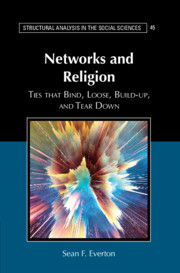Networks and Religion
Social scientists who study religion generally believe that social networks play a central role in religious life. However, most studies draw on measures that are relatively poor proxies for capturing the effects of social networks. This book illustrates how researchers can draw on formal social network analysis methods to explore the interplay of networks and religion. The book's introductory chapters provide overviews of the social scientific study of religion and social network analysis. The remaining chapters explore a variety of topics current in the social scientific study of religion, as well as introducing a variety of social network theories and methods, such as balance theory, ego-network analysis, exponential random graph models, and stochastic actor-oriented models. By embedding social network analysis within a social scientific study of religion framework, Networks and Religion offers an array of approaches for studying the role that social networks play in religious belief and practice.
- Illustrates how social scientists can use formal social network analysis (SNA) methods to better explore religious belief and practice
- The book begins with two introductory chapters: one that introduces the social scientific study of religion and one that introduces SNA, which will benefit readers with little or no background in either or both disciplines
- The book is organized topically (e.g. politics and community, health and happiness) which makes it accessible and interesting
Reviews & endorsements
'Although most social scientists who study religion agree that social networks play a central role in religious life, few studies draw on measures that adequately capture the effects of social networks. This book illustrates how researchers can draw on formal [Social Network Analysis] methods to explore the interplay of networks and religion.' American Sociological Association Section on Religion Newsletter
Product details
September 2018Hardback
9781108416702
410 pages
235 × 157 × 26 mm
0.68kg
68 b/w illus. 13 tables
Available
Table of Contents
- Part I. Introduction:
- 1. The surprising (at least to some) persistence of religion
- 2. Social network analysis: a brief introduction
- Part II. Ties that Bind:
- 3. Recruitment and conversion
- 4. Commitment and conformity
- Part III. Ties that Loose:
- 5. Diffusion and innovation
- 6. Politics and community
- Part IV. Ties that Build-Up:
- 7. Networks and tradition
- 8. Health and happiness
- Part V. Ties that Tear Down:
- 9. Conflict and cohesion
- 10. Radicalization and violence
- Part VI. Conclusion:
- 11. Conclusion
- Appendices
- References
- Index.





